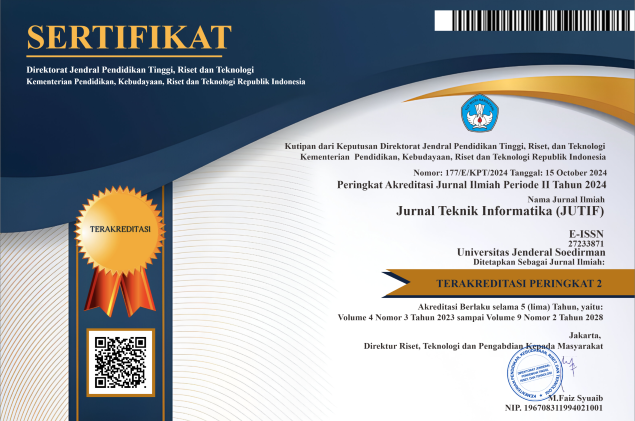An Enhanced Particle Swarm Optimization with Mutation for Mean-Value-at-Risk Portfolio Optimization in the Indonesian Banking Sector
DOI:
https://doi.org/10.52436/1.jutif.2025.6.4.5191Keywords:
Indonesian Banking Sector, Mean Value-at-Risk, Mutation Operator, Particle Swarm Optimization, Portfolio OptimizationAbstract
Portfolio optimization in emerging markets is challenging because high volatility and non-normal return distributions reduce the effectiveness of traditional mean–variance models, which tend to underestimate downside risk. This study aims to develop and evaluate an Enhanced Particle Swarm Optimization with Mutation (PSO with Mutation) for portfolio optimization under the Mean-Value-at-Risk (Mean-VaR) framework in the Indonesian banking sector. The novelty of this approach lies in integrating a mutation operator into standard PSO to maintain population diversity, prevent premature convergence, and improve exploration of the solution space. To evaluate the method, daily adjusted closing prices of 31 Indonesian bank stocks from January 2020 to July 2025 were collected. Preprocessing included removing tickers with incomplete data and computing daily returns. The optimization problem was formulated using Mean-VaR as the risk measure, with portfolio weight constraints. The proposed PSO with Mutation was benchmarked against standard PSO, Genetic Algorithm (GA), Bat Algorithm (BA), BA with Mutation, and classical models (Markowitz and Monte Carlo–based VaR). Performance was assessed using expected return, Mean-VaR, risk-adjusted return, Sharpe ratio, execution time, and stability across 25 independent runs. The results show that PSO with Mutation achieved a competitive expected return (0.0020), the lowest Mean-VaR (0.0311), the highest risk-adjusted return (0.0650), and the lowest variability across runs, while maintaining acceptable execution time. These findings confirm that mutation-enhanced PSO provides a robust, balanced, and efficient solution for portfolio optimization, making it highly relevant for investors in volatile emerging markets and advancing research on hybrid metaheuristics in financial optimization.
Downloads
References
Y. Wang, “Select the optimal portfolio by analyzing and comparing the better performance of Markowitz model and index model under 5 different constraints,” Advances in Economics Management and Political Sciences, vol. 13, pp. 364–376, 2023, doi: 10.54254/2754-1169/13/20230753.
C. Rodríguez and K. Rodríguez, “The variance-covariance model as a decision support for chartered financial analysts in portfolio optimization,” Brazilian Journal of Business, vol. 5, no. 1, pp. 428–438, 2023, doi: 10.34140/bjbv5n1-027.
L. Bo, “Portfolio optimization based on complex networks and genetic algorithms,” Academic Journal of Computing & Information Science, vol. 10, no. 6, pp. 85–92, 2023, doi: 10.25236/ajcis.2023.061013.
O. B. Adeoye, C. C. Okoye, O. C. Ofodile, O. Odeyemi, W. A. Addy, and A. O. Ajayi-Nifise, “Artificial intelligence in ESG investing: enhancing portfolio management and performance,” International Journal of Science and Research Archive, vol. 11, no. 01, pp. 2194–2205, 2024, doi: 10.30574/ijsra.2024.11.1.0305.
L. Runqing, “Application for machine learning methods in financial risk management,” in Proc. 3rd International Forum on Mathematical Statistics, Physical Sciences and Telecommunication System (Highlights in Science Engineering and Technology), Brussels, Belgium, 2024, pp. 775–778. doi: 10.54097/stt1va49.
F. Liu, “Risk management in derivatives markets: integrating advanced hedging strategies with empirical analysis,” in Proc. 2024 International Conference on Development of Digital Economy (SHS Web of Conferences), vol. 188, 2024. doi: 10.1051/shsconf/202418801008.
Q. Yuqi, J. Yuan, and Z. Wang, “Portfolio construction based on financial indicators,” in Proc. 4th International Conference on Economic Management and Model Engineering, ICEMME 2022, Nanjing, China, Nov. 2023. doi: 10.4108/eai.18-11-2022.2326932.
M. Karmakar and S. Paul, “Downside risk and portfolio optimization of energy stocks: a study on the extreme value theory and the vine copula approach,” The Energy Journal, vol. 44, no. 2, pp. 139–180, Mar. 2023, doi: 10.5547/01956574.44.2.mkar.
A. Balbás, B. Balbás, R. Balbás, and J. Charron, “Bidual representation of expectiles,” Risks, vol. 11, no. 12, pp. 1–21, 2023, doi: 10.3390/risks11120220.
C. S. Bhatnagar, D. Bhatnagar, V. Kumari, and P. S. Bhullar, “Sin versus green investment: a retrospective study on investor choice during pre- and through COVID regime,” Managerial Finance, vol. 49, no. 9, pp. 1474–1501, 2023, doi: 10.1108/mf-10-2022-0477.
Y. A. Ghulam and B. A. Joo, “Quantifying downside risk in Euro area stock markets: a Value at Risk study,” Review of Economics and Development Studies, vol. 9, no. 2, pp. 99–109, 2023, doi: 10.47067/reads.v9i2.486.
S. Schlütter, E. S. Fianu, and H. Gründl, “Responsible investments in life insurers’ optimal portfolios under solvency constraints,” Zeitschrift für die gesamte Versicherungswissenschaft, vol. 112, no. 1, pp. 53–81, 2023, doi: 10.3790/zverswiss.2023.03.schluetter.etal.
S. Menon, P. Mohanty, U. Damodaran, and D. Aggarwal, “Examining significance of ‘downside beta’ as a measure of risk – evidence from Indian equity market,” International Journal of Emerging Markets, vol. 20, no. 1, pp. 337–365, 2023, doi: 10.1108/ijoem-01-2021-0026.
Y. Hidayat, T. Purwandari, S. Sukono, I. G. Prihanto, R. A. Hidayana, and R. A. Ibrahim, “Mean-value-at-risk portfolio optimization based on risk tolerance preferences and asymmetric volatility,” Mathematics, vol. 11, no. 23, pp. 1–26, 2023, doi: 10.3390/math11234761.
D. Likitratcharoen and L. Suwannamalik, “Assessing financial stability in turbulent times: a study of generalized autoregressive conditional heteroskedasticity-type value-at-risk model performance in Thailand’s transportation sector during COVID-19,” Risks, vol. 12, no. 3, pp. 1–19, 2024, doi: 10.3390/risks12030051.
D. Saputra et al., “Value at risk analysis using historical method and Monte Carlo simulation in banking and mining sector companies,” International Journal of Applied Management and Business, vol. 1, no. 1, pp. 26–31, 2023, doi: 10.54099/ijamb.v1i1.436.
X. Jin, “Application of metaheuristic algorithm in intelligent logistics scheduling and environmental sustainability,” Intelligent Decision Technologies, vol. 18, no. 3, pp. 1727–1740, 2024, doi: 10.3233/idt-240280.
F. Cesarone, M. L. Martino, and F. Tardella, “Mean-Variance-VaR portfolios: MIQP formulation and performance analysis,” Or Spectrum, vol. 45, pp. 1043–1069, 2023, doi: 10.1007/s00291-023-00719-x.
H. Gao et al., “A novel motor structure with extended particle swarm optimization for space robot control,” Sensors, vol. 23, no. 8, pp. 1–23, 2023, doi: 10.3390/s23084126.
T. Song and L. Na, “Application and research of particle swarm optimization algorithm in cloud data backup,” in Proc. Second International Conference on Big Data, Computational Intelligence and Applications (BDCIA 2024), 2024, Huanggang, China, Mar. 2025. doi: 10.1117/12.3059171.
S. T. Rashmi Benni, “A comparative study of evolutionary and swarm intelligence algorithms for job scheduling on identical parallel machines,” Journal of Propulsion Technology, vol. 44, no. 4, pp. 3734–3745, 2023, doi: 10.52783/tjjpt.v44.i4.1531.
X. Wu, Y. Shan, and K. Fan, “A modified particle swarm algorithm for the multi-objective optimization of wind/photovoltaic/diesel/storage microgrids,” Sustainability, vol. 16, no. 3, pp. 1–22, 2024, doi: 10.3390/su16031065.
K. Tang and C. Meng, “Particle swarm optimization algorithm using velocity pausing and adaptive strategy,” Symmetry (Basel), vol. 16, no. 6, pp. 1–19, 2024, doi: 10.3390/sym16060661.
L. R. Zwerwer et al., “Identifying the need for infection-related consultations in intensive care patients using machine learning models,” Sci Rep, vol. 14, Jan. 2024, doi: 10.1038/s41598-024-52741-w.
F. J. López-Andreu et al., “Deep learning-based time series forecasting models evaluation for the forecast of chlorophyll a and dissolved oxygen in the mar menor,” J Mar Sci Eng, vol. 11, no. 7, pp. 1–26, 2023, doi: 10.3390/jmse11071473.
F. Ricci, L. Petrucci, and F. Mariani, “Hybrid LSTM + 1DCNN approach to forecasting torque internal combustion engines,” Vehicles, vol. 5, no. 3, pp. 1–14, 2023, doi: 10.3390/vehicles5030060.
K. Shao, H. Fu, and B. Wang, “An efficient combination of genetic algorithm and particle swarm optimization for scheduling data-intensive tasks in heterogeneous cloud computing,” Electronics (Basel), vol. 12, no. 16, pp. 1–17, 2023, doi: 10.3390/electronics12163450.
A. Malviya et al., “Optimization of life cycle cost and environmental impact functions of NiZn batteries by using Multi-Objective Particle Swarm Optimization (MOPSO),” Sustainability, vol. 16, no. 15, pp. 1–28, 2024, doi: 10.3390/su16156425.
H. Su, Q. Niu, and Z. Yang, “Optimal power flow using improved cross-entropy method,” Energies (Basel), vol. 16, no. 14, pp. 1–33, 2023, doi: 10.3390/en16145466.
D. T. Putri Anggraeni, E. T. Wahyuni, and H. Ritchi, “Does Covid-19 pandemic increase the use of cashless banking digital services? The case of Indonesia,” Jurnal Riset Akuntansi Kontemporer, vol. 15, pp. 37–46, 2023, doi: 10.23969/jrak.v15i1.6248.
N. A. Rizal, R. B. S. Kumar, and I. Gurrib, “Stock return prediction model in Indonesia,” Jurnal Manajemen Indonesia, vol. 23, no. 3, pp. 350–363, 2023, doi: 10.25124/jmi.v23i3.6622.
A. Nurullah, E. O. Donata Gozali, R. S. Hamzah, H. Bakti, R. Khasman, and M. A. Maharani, “An assessment of banking sector performance in Indonesia,” International Journal of Financial Accounting and Management, vol. 5, no. 4, 2024, doi: 10.35912/ijfam.v5i4.1452.
M. D. Mon, Calvin, and Y. Yuswardi, “Analysis of factors affecting turnover intention in BPR Batam City Bank employees,” International Journal of Economics Business and Management Research, vol. 8, no. 1, pp. 126–145, 2024, doi: 10.51505/ijebmr.2024.8109.
A. R. Bayu Saragih, “Determinant factors analysis of bank profitability: study on indonesian banks period 2019-2022,” Journal Integration of Management Studies, vol. 1, no. 2, pp. 250–262, 2023, doi: 10.58229/jims.v1i2.123.
Sukono, S. Supian, H. Napitupulu, Y. Hidayat, and A. S. Putra, “The application of genetic algorithm optimization on quadratic investment portfolio without a risk-free asset under Value-at-Risk,” J Phys Conf Ser, vol. 1090, no. 1, p. 12026, Sep. 2018, doi: 10.1088/1742-6596/1090/1/012026.
S. Chaube, “Construct an empirical study on the concept, modern portfolio theory Using Markowitz model,” J Algebr Stat, vol. 9, no. 1, pp. 69–74, 2023, doi: 10.52783/jas.v9i1.1440.
R. H. Kahar, N. P. Kaerudin, and W. Vimelia, “Optimal portfolio risk analysis using the Monte Carlo method,” Operations Research International Conference Series, vol. 4, no. 4, pp. 163–167, 2023, doi: 10.47194/orics.v4i4.276.
Moh. A. Amal, H. Napitupulu, and S. Sukono, “Particle swarm optimization algorithm for determining global optima of investment portfolio weight using mean-Value-at-Risk model in banking sector stocks,” Mathematics, vol. 12, no. 24, pp. 1–33, 2024, doi: 10.3390/math12243920.
Additional Files
Published
How to Cite
Issue
Section
License
Copyright (c) 2025 Syaiful Anam, Hilmi Aziz Bukhori, Avin Maulana, M. Idam Maulana, Hady Rasikhun

This work is licensed under a Creative Commons Attribution 4.0 International License.



























